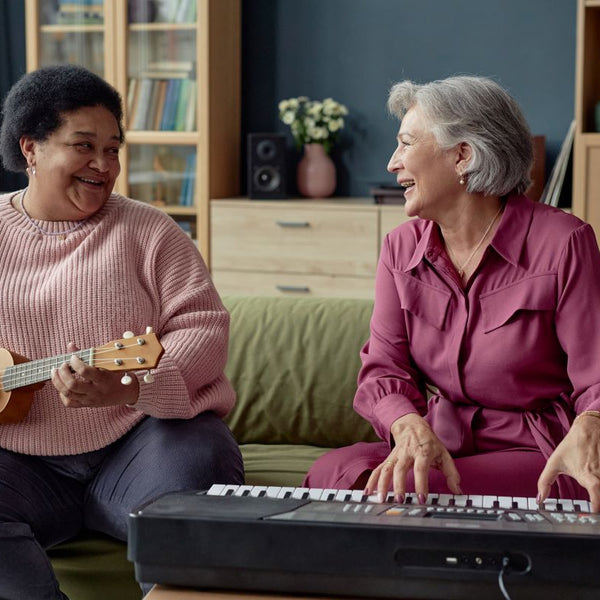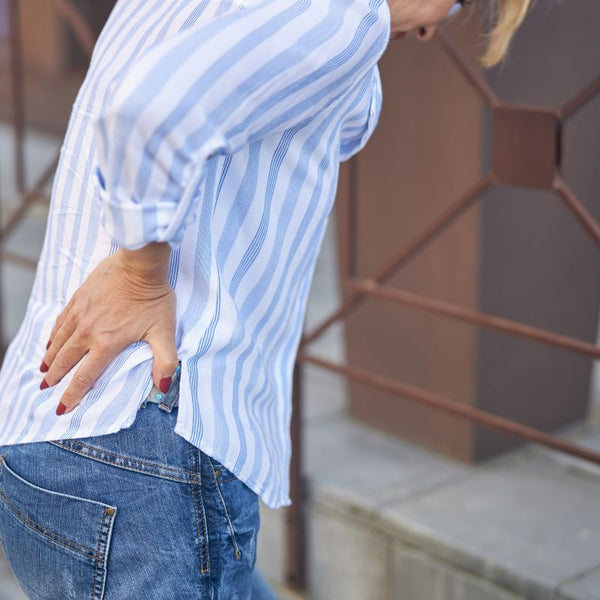The benefits of exercise for older adults are well known, but many people find staying active more of a challenge as they age. They may have health conditions that affect their mobility or their ability to do some of the physical activities they used to. This can not only have a negative physical impact on people in later life, increasing the risk of certain medical conditions developing, it can also affect their mental health and general quality of life too.
In this article, we look at why walking regularly can have multiple benefits for seniors physically, mentally and socially, and provide some walking tips for the elderly who want to do more of this form of exercise. We also include ideas for those who may have some mobility issues and might not be able to walk far unaided currently.
Jump to:
- The physical and health benefits of walking for older adults
- The mental benefits of walking for the elderly
- The social benefits of walking in later life
- Walking tips for the elderly
- Walking aids for older people with mobility issues
- Peace of mind when out walking
The physical and health benefits of walking for older adults

Even fairly light activity such as walking is beneficial to physical health for people of any age, but those in later life can potentially see even more positive impact over time.
Regular walking is known to contribute towards:
- Keeping the heart healthy
- Supporting digestion
- Boosting the immune system
- Reducing pain and inflammation in some chronic conditions, such as sciatica or joint pain
- Improving muscle strength
- Lowering blood sugar if walking after a meal
- Improving circulation
- Slowing down cognitive decline
- Reducing general aches and pain
- Improving the quality and duration of sleep
- Reducing the risk of developing some cancers
- Reducing the risk of developing Type 2 diabetes
- Helping to prevent the onset of osteoporosis, which makes bones more brittle and likely to fracture
- Improving balance, which can reduce the risk of falls
The mental benefits of walking for the elderly
Alongside the physical and health benefits of walking for seniors, there are also plenty of ways in which it can help improve mental health and lift someone’s mood. Many older adults experience depression and anxiety (even if they might not realise or recognise it) and getting moving more is known to trigger the release of chemicals in the brain that can make the individual feel more relaxed and happier naturally. Going for a walk gets older adults away from things that they might find stressful and gives them space to think, or to switch off and focus just on their environment instead. This can have a positive impact on mood and somewhat clear the mind.
The social benefits of walking in later life
Walking isn’t something that has to be done alone. Many older people find that they have friends, neighbours or family members who would love to take a walk together regularly. It can give them a chance to chat and catch up as well as being great exercise.
For those older adults who don’t have anyone to walk with, many local communities have walking groups specifically aimed at people in later life. They often start or finish (or both) near a café or somewhere people can stop for a drink, a snack and a chat, so can be a great way to meet new like-minded people and make social connections.
Walking regularly with a friend, family member or group can help to combat isolation and loneliness, which can be a real issue for many older adults.
Walking tips for the elderly

We’ve compiled some tips for seniors who would like to walk regularly for exercise.
Find comfortable clothes and footwear for walking
It’s important to wear clothing that’s suitable for walking, whatever the season. Well-fitting footwear that gives the right arch and ankle support, as well as a cushioned sole. Elderly foot care is very important as many older adults experience problems with their feet and this can lead to serious consequences if not managed effectively.
For most people, a pair of good trainers is a great option for walking day-to-day, and a pair of walking shoes or boots could be a good idea for those who hike regularly.
In terms of clothing, wearing several thin layers when walking can be a good idea, so that clothing can be removed or added as needed to keep the older person’s body temperature comfortable. Dressing for the weather is always important, to make sure the wearer can stay warm and dry while they walk.
A brightly coloured outer layer can be a good idea so that the walker can easily be seen by others.
Start small
When starting to walk for exercise as an older adult, it’s important to begin with short and easy walks, letting the body get used to this kind of movement before gradually making walks a bit longer and more strenuous.
Simple things such as getting off the bus a stop earlier than normal to make the walk home from the bus stop a little longer, or parking a little further away from the destination if driving, can make a real difference over time and help improve fitness, strength and stamina.
Set some goals
When trying to commit to walk regularly, lots of people find that a bit of extra motivation can help make it a habit, so setting some little goals can be beneficial.
Some examples could include:
- Commit to going for a walk every morning – many older people can feel a bit achy or stiff in the mornings. A morning walk can help to ease this.
- Set a goal for a realistic place/destination to walk to.
- Set a goal for the number of ‘steps’ to do each day which is realistic for the current mobility and fitness level. Most smartphones have the ability to count daily steps, or there are dedicated fitness and step trackers available.
- Set a goal for a daily, weekly or monthly distance that can increase over time as you get fitter. For example, starting at half a mile a day, then gradually increasing this.
Be prepared before setting out
It’s always important to consider safety when doing any kind of exercise, and older adults walking is no exception. Taking some time to get prepared can make all the difference. Some tips include:
- Ensure the walker has the right kind of clothing and footwear for the expected weather. If bad weather is expected, perhaps save the walk for another time, or do some walking indoors (covered shopping centres can be a good place for this as an alternative to walking indoors at home).
- Try to walk only in daylight hours.
- If the temperatures are high (such as over 20°C), don’t walk during the warmest parts of the day between 11am – 3pm.
- Take a water bottle to help stay hydrated on the walk.
- If walking alone, let someone know the planned destination and what time they expect to get back.
- Take a phone when going out walking.
- Wear a GPS-enabled personal alarm system when out walking, such as a wrist alarm for elderly people, which will ensure help can be reached and the walker’s location can always be found if something happens while out and about.
- Apply suncream to any exposed skin before setting off, even if it’s a cloudy day.
Walking aids for older people with mobility issues

It’s important that anyone with existing health conditions speaks to their GP before starting any new kinds of exercise, including walking. This is to make sure that it’s a suitable activity for them in their specific circumstances. If some gentle walking is considered a good idea by medical professionals, we’ve compiled some tips that may be helpful in getting started.
Many older people who cannot walk far unaided currently might think that automatically counts them out of walking for exercise in later life. However, depending on the individual situation, it might be that some walking aids can be used. This can potentially enable an elderly person with some mobility problems to start walking small distances and gradually gain fitness, stamina, improve their overall health and sometimes improve their mobility too.
Walking aids can potentially benefit those older people who need a bit of extra support when walking, but it’s important to find the solution that suits the individual best. Some of the equipment can be expensive, but local health services, communities and walking groups often have walking aids that can be borrowed for free or hired for a small fee, so this is a good idea when trying out different aids to find what helps the most.
Walking poles for seniors
Walking poles are used by walkers of all ages on some longer hikes, but they can be useful for older walkers even on short outings. The right walking poles can give extra stability and support, while limiting impact on joints, which is ideal for many walkers in later life.
They come in a variety of different types, including adjustable walking poles and solid walking poles. Ideally for older walkers, the poles should be quite lightweight and have a comfortable grip section.
A walking stick / cane for senior walkers
The classic walking aid for many older people is a walking stick or cane. Elderly walkers will generally only use one walking stick (compared to two walking poles) and this option might suit senior walkers that have limited mobility in one leg or side of the body but not the other. Walking sticks or canes can offer support for joints and help with balance when walking.
A walking frame / rollator for seniors

A rollator, which is basically a walking frame on wheels, offers senior walkers quite a lot of support and stability when walking. They are usually adjustable, so can be adapted easily to suit the individual, and one of the key benefits is that they tend to make the user feel safer while walking and give more confidence.
Peace of mind when out walking
For those who walk on their own or simply want some additional peace of mind while out walking, a personal alarm system designed to work anywhere in the UK could be a great option.
With GPS technology, the alarm will send the walker’s location, as well as an alert, if they press the emergency button. This might be if they have a fall or accident while out, if they become lost or disorientated or feel unwell. The device will put the individual in touch with the monitoring team, who can provide reassurance, get in touch with the nominated contact or arrange assistance from the emergency services if needed.
View our full range of personal alarms online. Our alarm products have a variety of features to suit different lifestyles and preferences. If you have any questions, you can call our Independent Living advisors for more information on which product would be best suited to your circumstances. Our team is available on 0800 085 7371 (Mon – Fri, 9am – 5pm).




